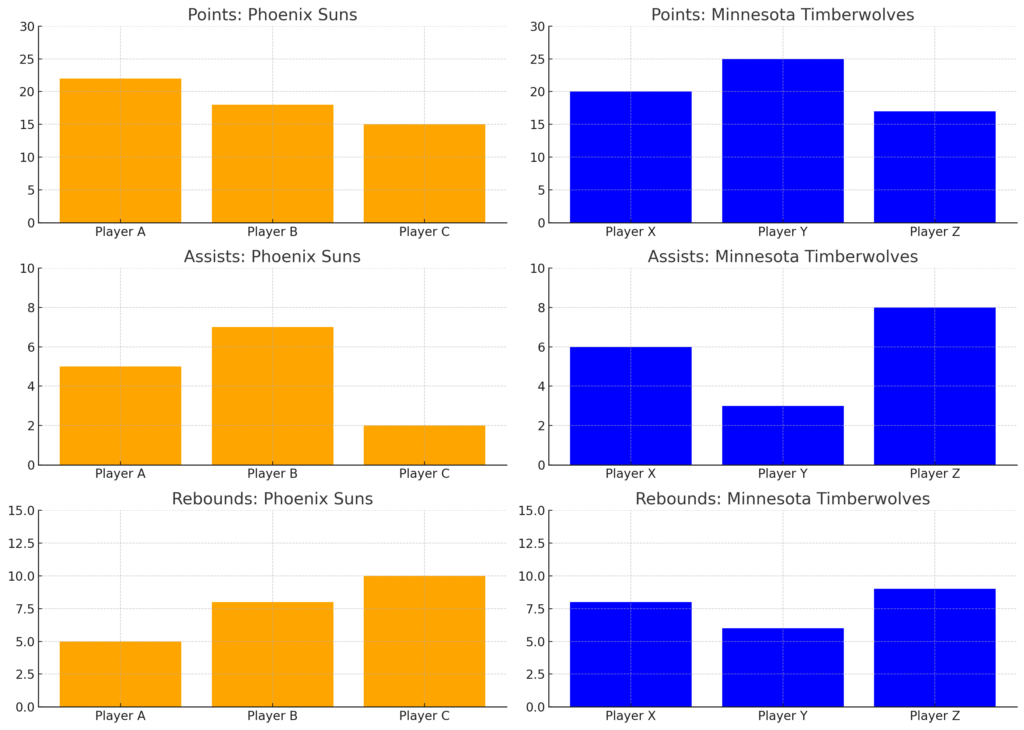Introduction
In the thrilling encounter between the phoenix suns vs timberwolves match player stats , and strategic executions painted a vivid picture of the game. This match, marked by intense plays and strategic depth, showcased the unique strengths and occasional weaknesses of both teams.
Exciting Game Overview Phoenix Suns vs Timberwolves Match Player Stats
The Phoenix Suns vs Timberwolves Match Player Stats brought their best to the court, making this game a showcase of basketball prowess. The player statistics not only reflect individual performances but also highlight the tactical approaches employed by each team.
Phoenix Suns Strategy and Execution
The Phoenix Suns’ approach in their recent game against the Minnesota Timberwolves was a masterclass in strategic planning and execution. Opting for a high-octane offense, the Suns focused on maximizing their efficiency from behind the arc and capitalizing on fast breaks. Their game plan revolved around quick ball movement and exploiting mismatches on the perimeter, which allowed them to stretch the defense and create scoring opportunities. Defensively, they aimed to disrupt the Timberwolves’ rhythm by implementing a mix of man-to-man and zone defenses, occasionally pressing full court to force turnovers.
Key Players in the Spotlight: Phoenix Suns
- Devin Booker: As the offensive spearhead, Booker’s scoring ability was crucial. He effectively utilized screens to get open and made significant plays that kept the momentum in favor of the Suns.
- Chris Paul: Paul’s leadership and court vision were instrumental. His ability to read the game and make decisive passes set up many scoring opportunities, keeping the team’s dynamics fluid.
- Deandre Ayton: Ayton provided the Suns with a strong presence in the paint, both offensively and defensively. His rebounding and shot-blocking helped mitigate the Timberwolves’ size advantage inside.
Timberwolves Strategy and Execution
The Minnesota Timberwolves employed a contrasting strategy focused on leveraging their physicality and interior strength. The emphasis was on pounding the ball inside, utilizing their big men to dominate the paint and secure rebounds. Offensively, they looked to create isolation opportunities for their shooters, while defensively, they concentrated on protecting the rim and limiting the Suns’ penetration. The Timberwolves also attempted to slow the game down, setting up their offense in half-court sets to counter the Suns’ speed.
Key Players in the Timberwolves
- Karl-Anthony Towns: Towns was pivotal in the paint, using his versatility to score and defend. His ability to step out and hit mid-range shots also provided a crucial spacing element.
- Anthony Edwards: Edwards brought energy and scoring prowess, driving aggressively to the basket and challenging the Suns’ defenders.
- D’Angelo Russell: Russell’s playmaking and ability to hit clutch shots were vital. His perimeter shooting stretched the Suns’ defense and facilitated more open lanes for his teammates.
Game Turning Moment Phoenix Suns vs Timberwolves Match Player Stats
The pivotal moment came in the third quarter when the Suns executed a flawless 12-0 run, turning a tight game into a commanding lead. This surge was sparked by a series of fast breaks and three-pointers, capitalizing on the Timberwolves’ momentary lapses in defense.
Weaknesses Exposed During the Match
The Suns struggled with rebounding, often getting outmuscled under the basket. Conversely, the Timberwolves had difficulties with perimeter defense, allowing the Suns too many open looks from beyond the arc.
Stats Breakdown of Both Teams: A Comparative Analysis of Phoenix Suns vs Timberwolves Match Player Stats

Offensive Efficiency
The Phoenix Suns showcased superior shooting efficiency, particularly from the three-point line. Their strategy to capitalize on perimeter shooting was evident, as they converted a significant percentage of their attempts from beyond the arc. This not only boosted their scoring but also stretched the Timberwolves’ defense, creating additional space for mid-range and paint attacks.
Conversely, the Timberwolves focused on their inside game, utilizing their size and strength to dominate the paint. Their field goal percentage from two-point range was commendable, driven by effective post plays and rebounding prowess. However, their three-point shooting lagged, which limited their ability to keep up with the Suns’ scoring runs.
Rebounding Battle
Rebounding told another part of the story. The Timberwolves outperformed the Suns in both offensive and defensive rebounds. This advantage gave the Timberwolves more second-chance points and was critical in keeping the game close, despite their shooting woes from distance. The Suns, while struggling under the boards, managed to mitigate some of the damage through quicker transitions and by spreading the floor.
Turnovers and Assists
Turnover statistics revealed a disciplined approach from the Suns, who maintained a lower turnover rate compared to the Timberwolves. This aspect of play highlighted the Suns’ focus on ball security and efficient playmaking, spearheaded by their experienced backcourt. In terms of assists, the Suns demonstrated better ball movement, which was instrumental in creating high-quality shooting opportunities.
The Timberwolves, while aggressive, showed a tendency to commit more turnovers, which were costly in a game where every possession mattered. Their assist numbers were decent, reflecting an effort to circulate the basketball, but the lower efficiency in converting those passes into points was a detriment.
Defensive Metrics
Defensively, both teams had moments of brilliance. The Suns excelled in perimeter defense, limiting the Timberwolves’ effectiveness from long range. They also racked up more steals, which transitioned into easy points off fast breaks. The Timberwolves, however, showcased their ability to protect the rim, recording more blocks and contesting shots in the paint effectively.
Conclusion
This matchup between the Phoenix Suns vs Timberwolves Match Player Stats was a spectacle of strategic ingenuity and athletic excellence. While the Suns’ precision from distance ultimately gave them the edge, the Timberwolves’ resilience and strength inside the paint were commendable. Both teams exposed certain weaknesses that they will look to address in future contests, setting the stage for even more compelling matchups down the line.


